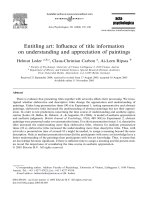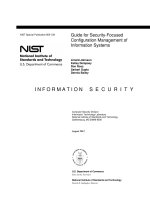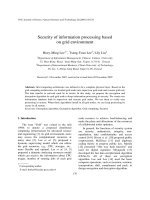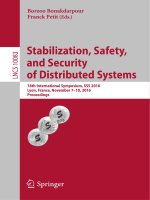Lecture On safety and security of information systems: Malicious attacks
Bạn đang xem bản rút gọn của tài liệu. Xem và tải ngay bản đầy đủ của tài liệu tại đây (1.1 MB, 39 trang )
Malicious Attacks
Contents
1)
Malicious Attack
2)
Attack Tools
3)
The common types of malicious attacks
4)
Malicious Software
1.Malicious Attack
What Is a Malicious Attack?
An attack on a computer system or network asset succeeds by exploiting a
vulnerability in the system.
What Is a Malicious Attack?
An attack can consist of all or a combination of these four categories:
a) Fabrications: involve the creation of some deception in order to trick
unsuspecting users.
What Is a Malicious Attack?
b) Interceptions: involve eavesdropping on transmissions and redirecting
them for unauthorized use.
What Is a Malicious Attack?
c) Interruptions: An interruption causes a break in a communication
channel, which blocks the transmission of data.
What Is a Malicious Attack?
d) Modifications: A modification is the alteration of data contained in
transmissions or files
2. Attack Tools
Attack Tools
Protocol analyzers
Port scanners
OS fingerprint scanners
Vulnerability scanners
Exploit software
Wardialers
Password crackers
Keystroke loggers
Protocol Analyzers
A protocol analyzer or packet sniffer is a software program that enables
a computer to monitor and capture network traffic.
Every data packet can be seen and captured by the sniffer.
Port Scanners
OS Fingerprint Scanners
An operating system (OS) fingerprint scanner is a software program that
allows an attacker to send a variety of packets to an IP host device, hoping
to determine the target device’s operating system (OS) from the responses
#nmap –O ip_address
Exploit Software
It is a program that can be used to exploit a weakness on the system
Vulnerability Scanners
A vulnerability scanner is a software program that is used to identify and,
when possible, verify vulnerabilities on an IP host device
Nexpose
Nessus
Kali Linux
Password Crackers
It is a software program that performs one of two functions: a brute-force
password attack to gain unauthorized access to a system or recovery of
passwords stored as a cryptographic hash on a computer system.
Kali Linux
Keystroke Loggers
It is a type of surveillance software or hardware that can record to a log
file every keystroke a user makes with a keyboard.
3. The common types of malicious attacks
Password attacks
Brute-Force Password Attack: the attacker tries different passwords on a
system until one of them is successful.
Dictionary Password Attack: a simple password-cracker program takes
all the words from a dictionary file and attempts to log on by entering each
dictionary entry as a password.
IP Address Spoofing
Spoofing is a type of attack in which one person, program, or computer
disguises itself as another person, program, or computer to gain access to
some resource.
IP spoofing
Address resolution protocol (ARP) poisoning
IP Address Spoofing
IP spoofing is the creation of Internet Protocol (IP) packets with a false
source IP address, for the purpose of hiding the identity of the sender or
impersonating another computing system
Address resolution protocol (ARP) poisoning
Hijacking
Hijacking is a type of attack in which the attacker takes control of a
session between two machines and masquerades as one of them.
Types of hijacking:
Man-in-the-middle hijacking
Browser or URL hijacking
Session hijacking
Replay Attacks
Replay attacks involve capturing data packets from a network and
retransmitting them to produce an unauthorized effect.
Man-in-the-Middle Attacks
An attacker intercepts messages between two parties before transferring
them on to their intended destination









